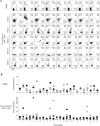Regulation of in vitro human T cell development through interleukin-7 deprivation and anti-CD3 stimulation
- PMID: 22897934
- PMCID: PMC3496569
- DOI: 10.1186/1471-2172-13-46
Regulation of in vitro human T cell development through interleukin-7 deprivation and anti-CD3 stimulation
Abstract
Background: The role of IL-7 and pre-TCR signaling during T cell development has been well characterized in murine but not in human system. We and others have reported that human BM hematopoietic progenitor cells (HPCs) display poor proliferation, inefficient double negative (DN) to double positive (DP) transition and no functional maturation in the in vitro OP9-Delta-like 1 (DL1) culture system.
Results: In this study, we investigated the importance of optimal IL-7 and pre-TCR signaling during adult human T cell development. Using a modified OP9-DL1 culture ectopically expressing IL-7 and Fms-like tyrosine kinase 3 ligand (Flt3L), we demonstrated enhanced T cell precursor expansion. IL-7 removal at various time points during T cell development promoted a slight increase of DP cells; however, these cells did not differentiate further and underwent cell death. As pre-TCR signaling rescues DN cells from programmed cell death, we treated the culture with anti-CD3 antibody. Upon pre-TCR stimulation, the IL-7 deprived T precursors differentiated into CD3+TCRαβ+DP cells and further matured into functional CD4 T cells, albeit displayed a skewed TCR Vβ repertoire.
Conclusions: Our study establishes for the first time a critical control for differentiation and maturation of adult human T cells from HPCs by concomitant regulation of IL-7 and pre-TCR signaling.
Figures









Similar articles
-
Exogenous IL-7 promotes the growth of CD3-CD4-CD8-CD44+CD25+/- precursor cells and blocks the differentiation pathway of TCR-alpha beta cells in fetal thymus organ culture.J Immunol. 1993 Apr 1;150(7):2706-16. J Immunol. 1993. PMID: 8095954
-
Distinct roles of IL-7 and stem cell factor in the OP9-DL1 T-cell differentiation culture system.Exp Hematol. 2006 Dec;34(12):1730-40. doi: 10.1016/j.exphem.2006.08.001. Exp Hematol. 2006. PMID: 17157170 Free PMC article.
-
Diverse T-cell differentiation potentials of human fetal thymus, fetal liver, cord blood and adult bone marrow CD34 cells on lentiviral Delta-like-1-modified mouse stromal cells.Immunology. 2009 Sep;128(1 Suppl):e497-505. doi: 10.1111/j.1365-2567.2008.03013.x. Epub 2008 Nov 20. Immunology. 2009. PMID: 19740310 Free PMC article.
-
αβ and γδ T cell receptors: Similar but different.J Leukoc Biol. 2020 Jun;107(6):1045-1055. doi: 10.1002/JLB.2MR1219-233R. Epub 2020 Jan 29. J Leukoc Biol. 2020. PMID: 31994778 Review.
-
In Vitro Model Systems to Study Human T Cell Development.Methods Mol Biol. 2023;2580:335-354. doi: 10.1007/978-1-0716-2740-2_21. Methods Mol Biol. 2023. PMID: 36374468 Review.
Cited by
-
Harnessing Mesenchymal Stromal Cells for the Engineering of Human Hematopoietic Niches.Front Immunol. 2021 Mar 15;12:631279. doi: 10.3389/fimmu.2021.631279. eCollection 2021. Front Immunol. 2021. PMID: 33790904 Free PMC article. Review.
-
Synergistic effects of interleukin-7 and pre-T cell receptor signaling in human T cell development.J Biol Chem. 2012 Sep 28;287(40):33826-35. doi: 10.1074/jbc.M112.380113. Epub 2012 Aug 2. J Biol Chem. 2012. PMID: 22859301 Free PMC article.
-
Thymic microenvironment's impact on immunosenescence.Immunol Res. 2024 Oct;72(5):1161-1173. doi: 10.1007/s12026-024-09519-z. Epub 2024 Jul 23. Immunol Res. 2024. PMID: 39042204
-
CAR-armed cell therapy for gliomas.Am J Cancer Res. 2019 Dec 1;9(12):2554-2566. eCollection 2019. Am J Cancer Res. 2019. PMID: 31911846 Free PMC article. Review.
-
Sorafenib Resistance Contributed by IL7 and MAL2 in Hepatocellular Carcinoma Can Be Overcome by Autophagy-Inducing Stapled Peptides.Cancers (Basel). 2023 Nov 3;15(21):5280. doi: 10.3390/cancers15215280. Cancers (Basel). 2023. PMID: 37958451 Free PMC article.
References
-
- Douek DC, Vescio RA, Betts MR, Brenchley JM, Hill BJ, Zhang L, Berenson JR, Collins RH, Koup RA. Assessment of thymic output in adults after haematopoietic stemcell transplantation and prediction of T-cell reconstitution. Lancet. 2000;355:1875–1881. doi: 10.1016/S0140-6736(00)02293-5. - DOI - PubMed
Publication types
MeSH terms
Substances
Grants and funding
LinkOut - more resources
Full Text Sources
Other Literature Sources
Research Materials
Miscellaneous

